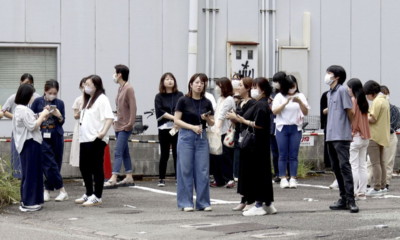
The Technical University of Munich: A Comprehensive Overview
-


Japan Coast Earthquake Triggers Tsunami Warning: A Detailed Analysis
-


Arshad Nadeem: Javelin Star Shines Bright at 2024 Olympics
-


Paraguayan Swimmer Luana Alonso Claps Back at Scandal: The Athlete Who Decline to Sink
-


Simone Biles Leads U.S. Women’s Gymnastics Team to Olympic Gold: A Historical Triumph
The Technical University of Munich (TUM), one of Europe’s leading universities, has established itself as a beacon of academic excellence, innovation, and research. Founded in 1868, TUM has a rich history of fostering advancements in science, engineering, and technology. Its global reputation, extensive research output, and commitment to education make it a prominent institution in the higher education landscape. This article delves into the university’s history, structure, research achievements, and impact on both local and international levels.
History and Evolution
The origins of TUM date back to the late 19th century, a period marked by rapid industrialization and scientific progress. Established on October 13, 1868, by King Ludwig II of Bavaria, the university was initially called the “Polytechnic School” and aimed to provide advanced engineering and applied sciences education. Its founding was part of a broader movement to support industrial and technical advancements in Bavaria.
Growth and Development
In the early 20th century, TUM experienced significant growth, both in terms of student hiring and academic breadth. The university expanded its curriculum to include various disciplines, including natural sciences and humanities. The mid-20th century brought about modernization and a focus on research excellence, which laid the groundwork for TUM’s future prominence.
The fall of the Berlin Wall and the subsequent reunion of Germany in 1989 marked a new era for TUM. The university seized this opportunity to strengthen its international connections and enhance its research capabilities. TUM’s commitment to interdisciplinary research and collaboration grew, further solidifying its position as a leading global organization.
Academic Structure and Faculties
TUM’s academic structure is designed to foster innovation and research across various disciplines. The university is organized into 14 schools and departments, each specializing in a clear field of study. This structure supports a multidisciplinary approach to education and research, allowing students and faculty to collaborate across traditional boundaries.
Schools and Departments
- School of Management: Known for its cutting-edge research in business and management, this school emphasizes innovation, entrepreneurship, and global business practices.
- School of Engineering and Design: Focused on engineering sciences and design, this school addresses contemporary challenges through technological advancements and creative solutions.
- School of Natural Sciences: This school covers a wide range of natural sciences, including physics, chemistry, and mathematics, and is renowned for its research in fundamental scientific questions.
- School of Life Sciences: Dedicated to biological and life sciences, this school investigates areas such as biotechnology, medicine, and environmental science.
- School of Architecture: This school combines architectural theory with practical design, focusing on sustainable and innovative approaches to architecture and urban planning.
- School of Informatics: A leader in computer science and artificial intelligence, this school heads digital transformation and technological innovation.
- School of Civil Engineering and Surveying: Specializing in civil engineering and surveying, this school addresses infrastructure challenges and advancements.
- School of Electrical and Computer Engineering: Known for its contributions to electrical engineering and computer science, this school explores areas such as telecommunications and embedded systems.
- School of Mathematics: This school focuses on pure and applied mathematics, contributing to various scientific and engineering disciplines.
- School of Social Sciences and Humanities: Bridging the gap between science and society, this school explores the impact of technological and scientific advancements on social structures and human behavior.
- School of Chemical Engineering: Emphasizing chemical processes and materials science, this school addresses challenges in chemistry and chemical engineering.
- School of Biotechnology: Dedicated to the applications of biotechnology, this school works on innovative solutions in health, agriculture, and industry.
- School of Aerospace Engineering: Focused on aerospace technologies, this school conducts research in aviation and space exploration.
- School of Environmental Sciences: Addressing global environmental challenges, this school investigates sustainable practices and environmental impact.
Research Excellence
TUM is renowned for its research output and contributions to various fields. The university hosts numerous research institutes and centers that drive innovation and technological advancement. Some of the remarkable research centers include:
- TUM Institute for Advanced Study (TUM-IAS): This institute fosters interdisciplinary research and provides support for pioneering projects in science and engineering.
- Munich School of Engineering: Focused on engineering research, this school collaborates with industry partners to address real-world challenges.
- TUM School of Medicine Research Center: Specializing in medical research, this center explores new treatments and technologies in healthcare.
- TUM Center for Sustainable Energy Systems: Dedicated to renewable energy and sustainability, this center researches energy efficiency and green technologies.
- TUM Center for Digitalization: This center focuses on digital transformation and its implications for various industries and sectors.
Major Research Achievements
TUM’s research achievements span a wide range of disciplines and have had a significant impact on both academia and industry. Some of the university’s notable contributions include:
- Space Exploration: TUM has been involved in several space missions, including collaborations with the European Space Agency (ESA) and NASA. The university’s research in space technology and satellite systems has contributed to advancements in space exploration.
- Medical Innovations: TUM researchers have made important strides in medical technology, including the development of new diagnostic tools and treatments for various diseases. The university’s work in personalized medicine and biotechnology has garnered international recognition.
- Sustainable Technologies: TUM’s research in sustainable energy and environmental technologies has led to the development of innovative solutions for reducing carbon emissions and improving energy efficiency. The university’s contributions to renewable energy sources and green technologies have had a global impact.
- Artificial Intelligence and Robotics: TUM is at the head of research in artificial intelligence (AI) and robotics. The university’s work in machine learning, autonomous systems, and robotics has led to advancements in automation and intelligent systems.
International Collaboration and Impact
TUM’s commitment to global collaboration is apparent in its extensive network of international partnerships. The university collaborates with leading institutions and organizations worldwide to advance research, exchange knowledge, and promote academic excellence. Some of TUM’s key international partnerships include:
- European Union Research Projects: TUM is actively involved in various European Union research projects, contributing to collaborative efforts in science and technology.
- Global University Networks: TUM is a member of several global university networks, including the EuroTech Universities Alliance and the International Association of Universities. These networks facilitate cooperation and knowledge exchange among member institutions.
- Industry Collaborations: TUM collaborates with numerous industry partners, including multinational corporations and startups. These partnerships increase research opportunities and facilitate the translation of academic discoveries into practical applications.
International Rankings and Recognition
TUM’s global reputation is reflected in its high rankings in various international university ranking. The university consistently ranks among the top universities in the world, especially in the fields of engineering, technology, and natural sciences. Some of TUM’s notable rankings include:
- QS World University Rankings: TUM consistently ranks among the top 50 universities globally, with high scores in engineering and technology.
- Times Higher Education World University Rankings:
- TUM is recognized for its research output and academic reputation, ranking among the top 100 universities worldwide.
- Academic Ranking of World Universities (ARWU):
- TUM is ranked among the top universities globally, particularly in engineering and technology disciplines.
Student Life and Campus Facilities
TUM’s main campus is located in Munich, Germany, and features state-of-the-art facilities that support both academic and extracurricular activities. The campus includes modern lecture halls, research laboratories, libraries, and amusing areas. Notable facilities include:
- TUM Library: A comprehensive resource center with large collections of academic literature, journals, and digital resources.
- Research Laboratories: Equipped with advanced technology and equipment, these laboratories support cutting-edge research in various disciplines.
- Student Accommodation: TUM provides housing options for students, including dormitories and student apartments, ensuring a comfortable living environment.
- Sports and Recreation: The university offers different sports facilities, including a fitness center, sports courts, and recreational areas for students to engage in physical activities.
Student Organizations and Activities
TUM boasts a alive student community with numerous organizations and activities that cater to diverse interests. Students can participate in various clubs, societies, and events, including:
- Student Clubs and Societies: TUM has a range of student clubs and societies focused on academic, cultural, and social interests. These organizations provide opportunities for students to connect with gentlemen and engage in extracurricular activities.
- International Student Community: TUM welcomes students from around the world, attending a diverse and inclusive campus environment. International students have access to support services and cultural exchange programs.
- Events and Conferences: The university hosts different events, conferences, and workshops that provide students with opportunities to network, learn from experts, and engage in professional development.
Future Directions and Goals
Strategic Vision
TUM’s strategic vision focuses on maintaining its position as a leading global university and driving advancements in science, technology, and education. Key goals for the future include:
- Enhancing Research Capabilities: TUM aims to further strengthen its research capabilities by investing in cutting-edge technology, fostering interdisciplinary collaboration, and addressing global challenges.
- Promoting Sustainability:
- The university is commit to promoting sustainability through research, education, and campus operations. TUM plans to continue its efforts in developing sustainable technologies and practices.
- Expanding Global Impact: TUM seeks to expand its global impact by strengthening international partnerships, increasing its presence in global research networks, and contributing to global solutions.
- Innovating Education:
- The university is focus on innovating

